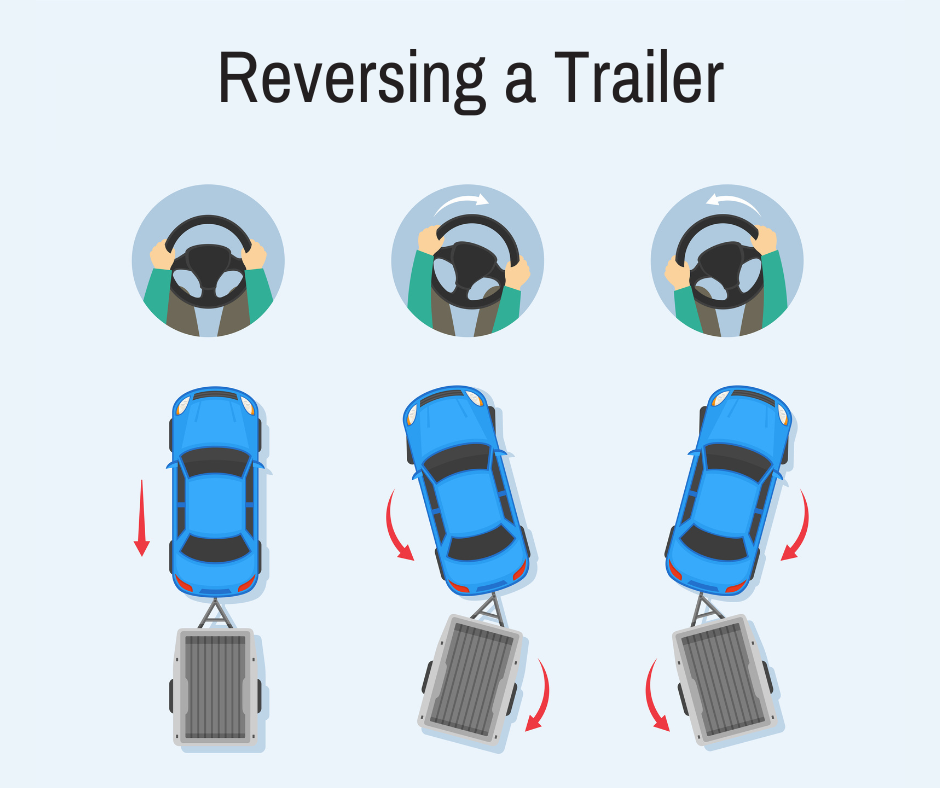A Beginner’s Guide to Backing Up a Trailer
There’s one trailer-hauling maneuver that often seems daunting to new and seasoned trailer owners alike: how to back up a trailer. Whether you’re backing into a parking spot, positioning your trailer in a storage area, or navigating through tight spaces, mastering this technique is crucial. When you break down the process and understand how the moving pieces work together, backing up a trailer becomes a much less confusing task. Kate’s Trailers is here to turn you into a towing-in-reverse expert with our step-by-step guide.
Understand the Basics
Before diving into the mechanics, it’s essential to understand why backing up with a trailer can feel so perplexing. Unlike driving forward, where your trailer follows your lead, reversing requires you to think inversely. The trailer reacts opposite to your steering wheel movements, which can feel counterintuitive at first. It’s also why mastering this skill takes patience and practice.

Preparation is Key
Preparing your trailer, tow vehicle, and the area you need to reverse in is the first step.
Know Your Trailer: Each trailer has its unique characteristics, such as length, weight, and turning radius. Familiarize yourself with these aspects to better understand how reversing your trailer will work. It’s important to know the length and turning radius in particular. Each model behaves differently, and understanding these nuances can significantly affect your technique.
Adjust Mirrors for Maximum Visibility: Ensure your vehicle’s side mirrors are well-adjusted to give you a clear view of the trailer’s sides. Visibility is crucial when learning how to back up a trailer. You can purchase additional tow mirrors for your vehicle if needed to extend your view. Many newer vehicles also include 360-degree cameras and other added features that can make reversing with a trailer easier.
Inspect the Area: Ensure the space you plan to back into is free of obstacles. Take note of any potential hazards that could affect your maneuvering. Move them out of the way before backing into the spot, if possible. Otherwise, simply make sure you’re aware of where they are before shifting into reverse.
Step-by-Step Guide on How to Back Up a Trailer
Position Your Vehicle and Trailer: Start by aligning your vehicle and trailer as straight as possible with the area you need to back into. This initial alignment simplifies the direction control as you begin to reverse. The easiest thing to do is reverse straight backward, after all.
Hand on the Bottom of the Steering Wheel: This trick is invaluable. By placing your hand at the bottom of the steering wheel, the direction you move your hand is the direction the rear of the trailer will go. If you want the trailer to go left, move your hand to the left, and vice versa.
Start Slow: Begin reversing slowly. Minor steering adjustments have a more significant impact when backing up a trailer, so slow and steady is the way to go. This allows for more precise adjustments and reduces the risk of overcorrection.
Use Small Corrections: Oversteering is a common mistake. Use small, gentle movements to adjust the trailer’s path. If you find the trailer veering off course, stop, pull forward to realign, and try again.
Monitor Both Sides: Constantly check both mirrors. Focusing on one side might lead you to miss what’s happening on the other. Your goal is to maintain an even distance on both sides of the trailer as it moves backward. This, again, is where extended mirrors and bird-eye-view cameras can be a great assistance.


Practice Makes Perfect: The most important piece of advice on how to back up a trailer is practice. Find a spacious, empty area to practice reversing in straight lines, slight curves, and eventually into parking spots or between cones.
Advanced Tips and Strategies
Use a Spotter: When possible, a spotter can guide you from outside, providing directions and helping you navigate blind spots. Just make sure you’ve agreed on clear hand signals beforehand.
Understand Pivot Points: The pivot point is where the trailer and tow vehicle meet. When reversing, the pivot point plays a critical role in determining the trailer’s direction. Visualize this point to better anticipate trailer movement.
Common Challenges and Solutions
Prevent Jackknifing: This occurs when the angle between your vehicle and trailer becomes too acute. To prevent it, watch your mirrors closely and correct the trailer’s direction early.

Navigating with Limited Visibility: In situations where visibility is poor, such as at night or in bad weather, take extra precautions. Use additional lighting if possible and go even slower to ensure safety. Lights and other materials are available at our Illinois trailer parts and service department.
Handling Narrow Spaces: Tight spaces require patience and sometimes multiple attempts. Don’t rush, and remember, it’s better to realign several times than to risk damaging your trailer or surroundings.
Assistance and Options at Kate’s Trailer Sales
Learning how to back up a trailer is a skill that comes with time and practice. By following our guide, you can become more comfortable and efficient at maneuvering your trailer in reverse. Remember, every trailer owner has been a beginner at some point. Patience, practice, and persistence are key to mastering this essential skill. At Kate’s Trailer Sales, we’re committed to supporting you through every step of your trailer ownership, from the basics of hitching up to the finesse of reversing in tight areas.
When it comes to selecting the perfect trailer, Kate’s Trailer Sales is here to help. Our extensive inventory of trailers for sale is designed to cater to every job, whether you’re a first-time buyer or looking to upgrade your current model.
Don’t shy away from seeking advice or assistance on backing up a trailer, or any other aspects of trailer ownership. And remember, the team at Kate’s Trailer Sales is always here to assist with your trailer needs.

